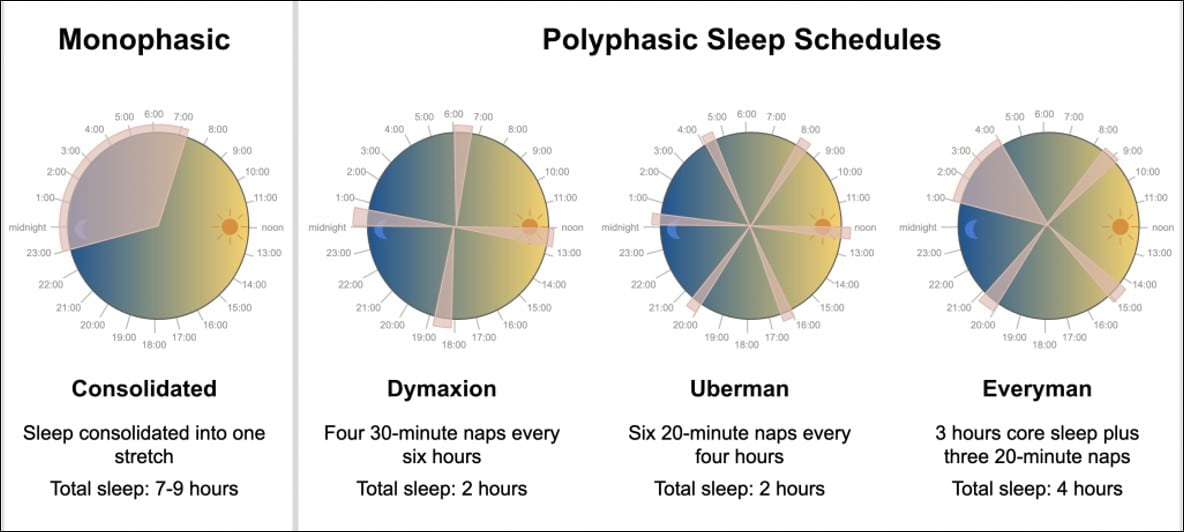Polyphasic sleep, a pattern where sleep is divided into multiple periods throughout the day instead of one long block, has sparked growing interest as a way to optimize wakeful hours and improve productivity.
While traditional, monophasic sleep—sleeping in a single stretch each night—is the norm for most people, polyphasic sleep maximizes alertness, memory, and even creativity by distributing sleep into shorter segments.
In this article, we'll explore the different types of polyphasic sleep schedules, their potential benefits, the challenges that come with them, and who might benefit most from adopting this sleep pattern.
What is Polyphasic Sleep?
Polyphasic sleep is defined by a pattern where an individual sleeps multiple times a day, rather than once in a single continuous period. To better understand the basics of how sleep works, it’s important to recognize the role of sleep cycles and their impact on rest and recovery."
There are several variations of polyphasic sleep schedules, but the key factor is the fragmentation of sleep into more than one segment.
Types of Polyphasic Sleep Schedules

Polyphasic sleep involves splitting sleep into multiple periods throughout the day, rather than sleeping in one long block as in monophasic sleep, which is the typical pattern of sleep where an individual sleeps once for a longer stretch (usually around 7-9 hours).
While monophasic sleep is common for most people, polyphasic sleep schedules aim to optimize waking hours by incorporating multiple sleep periods.
There are several variations of polyphasic sleep, each designed with different goals in mind, such as increasing productivity or improving cognitive function. Below are some of the most well-known polyphasic sleep schedules:
Everyman Sleep Schedule
The Everyman sleep schedule is one of the most popular and flexible forms of polyphasic sleep. It typically involves a longer core sleep period (around 3-4 hours) combined with several short naps (20-30 minutes each) spaced throughout the day.
This schedule is designed to maintain a balance between rest and wakefulness while allowing for a more manageable adaptation process.
Uberman Sleep Schedule
The Uberman sleep schedule is one of the most extreme polyphasic sleep patterns. It involves six 20-minute naps spaced evenly throughout the day, totaling just 2 hours of sleep in 24 hours.
This schedule requires strict adherence and a high level of discipline, but it is said to maximize wakeful hours and cognitive performance once fully adapted.
Dymaxion Sleep Schedule
The Dymaxion sleep schedule is another extreme approach to polyphasic sleep, consisting of four 30-minute naps spaced evenly throughout the day. This schedule also provides a very small amount of total sleep—just 2 hours—but claims to improve alertness and productivity during waking hours.
Other Variations
- Biphasic Sleep: Biphasic schedule involves splitting sleep into two blocks, typically a longer sleep period at night (about 5-6 hours) and a shorter nap during the day (around 1-2 hours). This schedule is often seen as a more natural approach to polyphasic sleep.
- Triphasic Sleep: Similar to biphasic sleep, but involves three sleep periods spread across the day. Each sleep phase might be around 3 hours, or the periods can be customized to fit individual needs.
- Custom Variations: Many people experiment with different sleep patterns to find what works best for them, which may include combinations of naps and core sleep periods.
Benefits of Polyphasic Sleep

Many people are drawn to polyphasic sleep for its purported benefits, particularly in terms of productivity, cognitive performance, and health. However, these benefits vary significantly from person to person and require proper adaptation to avoid negative effects.
Increased Wakeful Hours
By distributing sleep across multiple periods, polyphasic sleep allows for longer waking hours, which can be especially appealing for individuals who want to maximize their productivity.
Some proponents claim that polyphasic sleep can offer up to 6 additional hours of wakefulness each day, depending on the sleep pattern.
Improved Focus and Alertness
When properly adjusted to polyphasic sleep, some individuals report enhanced focus and mental clarity.
Napping during the day can help combat feelings of fatigue, making it easier to remain alert and productive. This is especially beneficial for those who need to maintain peak performance over extended periods.
Enhanced Memory Consolidation
Polyphasic sleep, with its multiple sleep cycles, can aid in memory consolidation. The shorter, more frequent sleep periods can enhance the brain's ability to process and store new information, improving learning and retention.
Better Sleep Quality for Certain Individuals
For some people, polyphasic sleep allows for deeper and more restorative rest during the core sleep period. Shorter naps throughout the day can also reduce sleep fragmentation, which may improve the overall quality of rest and prevent the grogginess associated with long periods of sleep.
Can Reduce Sleep Inertia
Sleep inertia refers to the groggy feeling people often experience upon waking, especially after long sleep sessions.
Polyphasic sleep, with its shorter naps, may help reduce this effect, making it easier to transition from sleep to wakefulness without the usual sluggishness.
May Help with Sleep Disorders in Certain Cases
In some cases, polyphasic sleep schedules have been used to help individuals with sleep disorders, such as insomnia or narcolepsy.
By redistributing sleep into smaller chunks, these individuals may be able to experience more consistent and restorative rest, potentially reducing the negative impact of fragmented or disrupted sleep patterns.
Improved Cognitive Function
Short naps throughout the day may promote better performance in tasks requiring attention, memory retention, and problem-solving.
Polyphasic sleep can help reduce the feeling of sleep inertia (the grogginess experienced upon waking) by reducing the risk of waking up during deep sleep stages.
Challenges and Risks of Polyphasic Sleep
Despite its potential benefits, polyphasic sleep comes with various challenges and risks, particularly for individuals who do not properly adjust to this sleep pattern.
Difficulty Adjusting
One of the biggest challenges with polyphasic sleep is the difficulty of adjusting to a new sleep schedule. The body is naturally attuned to a circadian rhythm that promotes longer, consolidated sleep periods.
Shifting to a polyphasic schedule requires significant adaptation, and the process can be uncomfortable, leading to sleep deprivation, fatigue, and irritability during the initial transition.
Social and Work Constraints
Polyphasic sleep schedules, especially the more extreme ones, can be difficult to maintain within the context of social and professional obligations.
Many people have work or social schedules that follow a standard 9-to-5 routine, which doesn’t align with the frequent naps required in polyphasic sleep. This can lead to feelings of isolation, missed social events, and difficulties at work due to irregular sleep patterns.
Higher Dependency on Naps
Polyphasic sleep systems rely heavily on naps throughout the day. For individuals who are not able to consistently fit these naps into their schedules, this can lead to an overall reduction in sleep quality and an increased reliance on short, fragmented rest periods.
Disrupted Hormonal Balance
Sleep plays a critical role in regulating various hormones in the body, including those related to stress, appetite, and growth. Disrupting the body’s natural sleep patterns with polyphasic schedules can interfere with hormonal regulation.
This could potentially lead to increased cortisol (stress hormone) levels, changes in appetite, and even disruptions in the body’s natural circadian rhythm, affecting overall health.
Potential for Chronic Sleep Deprivation
If the body is not given adequate time to recover, polyphasic sleep can result in chronic sleep deprivation. This can occur if an individual doesn’t fully adapt to the polyphasic schedule, leading to sleep fragmentation and insufficient total sleep.
Negative Impact on the Immune System
Sleep is essential for maintaining a healthy immune system. Proper rest plays a crucial role in sleep and immunity, as deep sleep supports the body’s ability to fight off infections and recover from illness. Polyphasic sleep, especially if not properly balanced, can interfere with the body’s immune responses.
Mental Health Effects
Polyphasic sleep can also have adverse effects on mental health. The constant shift in sleep patterns and potential sleep deprivation can contribute to anxiety, depression, and cognitive issues.
The disruption of regular, restorative sleep may exacerbate pre-existing mental health conditions or contribute to the development of mood disorders, particularly if the individual is not able to maintain a consistent sleep schedule.
Reduced Physical Recovery & Athletic Performance
For athletes and individuals engaging in regular physical activity, polyphasic sleep schedules can reduce the quality of physical recovery. Restorative sleep is critical for muscle repair, energy restoration, and overall physical recovery.
Increased Risk of Heart Disease and Diabetes
Chronic sleep deprivation, which can result from poorly managed polyphasic sleep, is associated with an increased risk of several long-term health problems, including heart disease and diabetes.
Disrupted sleep patterns can affect blood sugar regulation, increase blood pressure, and contribute to obesity—factors that heighten the risk for cardiovascular disease and metabolic disorders.
Who Should Consider Polyphasic Sleep?

Polyphasic sleep may not be suitable for everyone, and its potential benefits should be weighed carefully against the risks. However, it may be appropriate for certain individuals under specific circumstances.
Shift Workers
Shift workers who have irregular work hours may find polyphasic sleep beneficial. For example, those working night shifts or rotating shifts can adjust their sleep patterns to include naps during the day or between shifts, allowing them to maintain alertness and productivity despite the disruption of a regular sleep schedule.
High-Performance Individuals
People who require peak mental and physical performance, such as executives or entrepreneurs, might consider polyphasic sleep to maximize their waking hours.
With the right adaptation, polyphasic sleep can help increase focus, alertness, and productivity, allowing these individuals to stay sharp while working long hours.
Students and Researchers
Students and researchers often face intense study schedules, tight deadlines, and long hours of focus. For some, polyphasic sleep can help provide extra waking hours for study or research, improving productivity.
Competitive Gamers and Creative Professionals
Competitive gamers or creative professionals (e.g., writers, artists, and musicians) who need extended periods of wakefulness and focus might benefit from polyphasic sleep.
Napping can help restore cognitive function and prevent fatigue during long gaming sessions or intense creative work, allowing for better performance and more efficient use of time.
Emergency Responders
Emergency responders, such as paramedics, firefighters, or doctors working long shifts, may find polyphasic sleep beneficial. Short naps during off-hours can help maintain alertness and stamina, reducing the risk of fatigue-related mistakes and improving overall performance during critical moments.
Frequent Travelers
Frequent travelers, particularly those who cross multiple time zones, can use polyphasic sleep as a way to adjust their sleep schedules more quickly.
Napping throughout the day can help ease jet lag and reduce fatigue, making it easier to stay awake and alert while transitioning between time zones.
Short Sleepers
Some individuals naturally require less sleep and can function well on shorter amounts of rest. These “short sleepers” might find that polyphasic sleep allows them to maintain high levels of productivity while still getting enough rest.
However, this is not the same as sleep deprivation—these individuals can thrive on reduced sleep without negative effects on cognitive function.
People with Specific Health Goals
Polyphasic sleep can also be considered by people with specific health goals, such as those who need more time for exercise, meditation, or personal projects.
By adjusting sleep patterns to accommodate longer periods of wakefulness, individuals may have more time to focus on health-related goals like physical fitness, diet, or mindfulness practices.
Who Should Avoid Polyphasic Sleep?
Polyphasic sleep may not be ideal for everyone, but under certain circumstances, it can provide unique benefits.
Those who can maintain discipline and adapt properly may find polyphasic sleep a valuable tool. Below are some groups of people who might benefit from adopting a polyphasic sleep schedule:
Athletes & Physically Active Individuals
For athletes and those engaged in intense physical activity, sleep plays a crucial role in recovery, muscle repair, and energy restoration. Polyphasic sleep, particularly extreme schedules, may reduce the quality of deep sleep needed for physical recovery.
Individuals with Chronic Health Conditions
People with chronic health conditions such as diabetes, cardiovascular disease, or autoimmune disorders may find polyphasic sleep too demanding on their bodies. Adequate, uninterrupted sleep is essential for managing and recovering from these conditions.
Anyone Unable to Maintain a Strict Schedule
Polyphasic sleep schedules require strict adherence, including the need for naps and specific sleep windows throughout the day. Those who cannot commit to maintaining this rigid schedule—due to work commitments, family responsibilities, or lifestyle factors—may find polyphasic sleep impractical or detrimental.
How to Transition to a Polyphasic Sleep Schedule
Transitioning to a polyphasic sleep schedule requires careful planning and gradual adjustment. Here are some steps to help ease the transition:
- Start Slowly: Don’t jump straight into an extreme schedule. Start by gradually reducing your core sleep period while adding in short naps. For example, try shortening your nighttime sleep by 30 minutes each week while incorporating one nap during the day. Allow your body time to adjust.
- Be Consistent: Consistency is crucial when adopting a polyphasic sleep schedule. Stick to your sleep and nap times as closely as possible each day to help regulate your internal clock. Avoid long, irregular gaps between sleep periods.
- Adjust Your Environment: Create an optimal sleep environment for both your core sleep and naps. Ensure that your sleep space is quiet, dark, and comfortable. Consider using blackout curtains, white noise machines, or eye masks to promote restful sleep during shorter periods.
- Listen to Your Body: Pay attention to how your body responds as you adjust to a polyphasic sleep pattern. If you experience excessive fatigue, difficulty focusing, or mood changes, it may be a sign that the schedule is too extreme or that more rest is needed. Gradual adjustments and listening to your body are key to making a successful transition.
- Manage Energy Levels: Make sure to maintain a balanced diet and engage in regular physical activity to support your energy levels during the transition. Proper nutrition and exercise can help mitigate the negative effects of sleep deprivation and boost alertness during waking hours.
- Give It Time: Transitioning to polyphasic sleep can take several weeks, depending on the individual. Your body will need time to adapt, so be patient and give yourself grace if you experience setbacks. Stick to the schedule as best as you can, but allow for flexibility in the early stages.
- Monitor Your Health: Pay attention to any physical or mental health changes during the transition. If you start experiencing negative effects, such as increased stress, cognitive impairment, or sleep disruptions, reconsider whether polyphasic sleep is right for you.
FAQs
What are the benefits of polyphasic sleep?
Polyphasic sleep proponents claim it increases waking hours and productivity. The idea is to maximize REM sleep through shorter, more frequent sleep cycles. Some individuals report improved alertness and energy. However, there’s limited scientific evidence supporting these benefits, and the long-term effects on health are still unclear.
Are there any risks associated with polyphasic sleep?
Polyphasic sleep can disrupt the natural sleep cycle, leading to potential risks such as sleep deprivation, mood issues, cognitive decline, and weakened immunity. The body may struggle to enter deep sleep stages, which are essential for physical and mental restoration. Long-term adherence may harm overall health and well-being.
How does polyphasic sleep compare to monophasic sleep?
Monophasic sleep involves one continuous sleep block, typically 7-9 hours, which supports the body's natural circadian rhythm. Polyphasic sleep, however, involves multiple sleep periods, often leading to fragmented rest. Monophasic sleep generally supports deeper sleep stages, while polyphasic sleep may limit restorative sleep, affecting overall health and performance.
Can polyphasic sleep work for everyone?
Polyphasic sleep doesn’t work for everyone. Some people can adapt, while others experience fatigue, reduced focus, or mood changes due to insufficient rest. It may not be suitable for individuals with high physical or mental demands or specific health conditions. Consulting a healthcare professional before trying it is recommended.
Conclusion
Polyphasic sleep can offer unique advantages for individuals looking to maximize their waking hours, improve productivity, and optimize cognitive performance. However, it’s important to approach polyphasic sleep with caution, as it requires significant adaptation and discipline.
Karen Barnard
Karen is a Human Movement Science expert and a certified sports nutrition and massage therapist. At Sleepiverse, she combines her passion for human movement science and sleep health to educate herself and her readers about healthier sleep. In addition to writing articles, Karen manages a fitness studio offering private training, athletic conditioning, and sports massage therapy. She focuses on providing people with a holistic environment for people to reach their health goals, often incorporating stretch therapy to promote mental tranquillity and help people improve their sleep.


